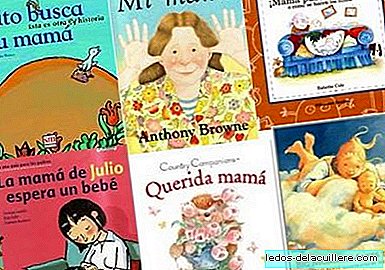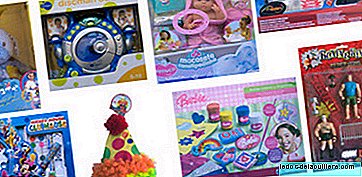
Yesterday we started a summary guide with the main foods we have to offer babies. As we were halfway, today we continue with the guide.
Meat
- Chicken and rabbit, which can begin to be offered after six months, are less allergenic meats and more suitable for babies, because they come from small animals.
- Turkey, lamb and veal can also start taking it at six months, although the veal, being a larger animal, has a lot of collagen that is difficult to digest (for this reason it is often recommended after 10 -12 months). As for the turkey, it is an interesting meat for being one of the most iron contains.
- Pork can also be given at six months, although at this age it would offer as much as the pork tenderloin, which is a juicy and nerve-free meat, keeping a little watch on the baby's digestions (the pig, like veal, is a little more indigestible for babies than other meats of smaller animals). The ham and the serrano, for its amount of salt and the amount of preservatives and dyes they usually carry (basically that of york), would be more recommended from 10-12 months.
Fish

Fish is one of the foods in which there is less consensus. Now you will see it:
Fish can begin to be offered, depending on the AEPED, from nine months, since babies tolerate it badly because they delay gastric emptying, they can cause allergic reactions and contain toxic substances (mercury and boric acid).
The AAP (American Pediatric Association) recommends instead not offering fish up to three years.
The AESAN (Spanish Agency for Food Safety and Nutrition) indicates that the baby with an allergy or at high risk of suffering from it must wait three years, starting with swordfish, bonito, tuna, flounder and other flatfish and finally cod and hake, which are the ones that cause the most allergies, but of course, it speaks of babies with a high risk of allergies.
Faced with such a difference I would choose to start from the twelve months because of the risk of allergy, although the nine months don't seem like a bad start to me either.
There are those who differentiate between white fish and blue fish, starting white rather than blue (white towards 9-12 months and blue towards 18 months). The truth is that both could be offered after twelve months, although obviously nothing happens to delay a food.
Vegetables

The vegetables they can begin to be offered at six months and, in fact, being rich in iron, it is recommended to do so (although they must be accompanied by some food with Vitamin C to improve iron absorption: orange, tangerine, tomato, ...).
If the baby suffers flatulence from the skin of the legumes, it is better to remove them. If even removing the skin, legumes continue to produce flatulence, it is better to wait a while to offer them again.
Green beans are probably the best tolerated and so they can be given in peace at six months.
Soy is one of the foods considered highly allergenic, so it is recommended to start offering it at 12 months.
Egg

He egg It is one of the foods with more allergenic potential and therefore it is recommended to start offering it after 12 months.
In some publications it is recommended to separate the yolk from the white, to first offer the yolk, which is less allergenic, by 10 months. However, it has been proven that part of the white ends up leaving with the yolk in the separation.
Despite this, many children have shown symptoms after taking the white having previously tolerated the yolk.
I, just in case, would not offer until twelve months, starting with the yolk and offering a week later, to leave room in case there were symptoms, the clear.
Milk and derivatives

The milk and its derivatives They are highly allergenic (milk is, in early childhood, the food that produces the greatest number of adverse reactions) and is therefore recommended delay them up to 12 months. Children who drink artificial milk are already taking protein from cow's milk, so at the level of allergies, if they tolerate it well, there is no problem.
These children could take natural yogurt from 9-10 months (although since they have more protein than artificial milk, better a bottle than a yogurt) and cow's milk from 12 months. Breastfed babies better all from 12 months.
Other foods

- Salt makes children eat more than they need since it is a taste they like. You also run the risk of getting used to this flavor and having a hard time accepting other less salty flavors. It could start offering from 12 months, although in moderation.
- Sugar produces the same effect as salt, causing you to eat too much and get used to that taste, but with the addition that it is a demineralizing food. It is also not recommended until at least 12 months (and thereafter avoid it as much as possible).
- Honey is the natural alternative to sugar as it sweetens equally and is somewhat healthier. May contain spores of Clostridium Botulinum, which can be absorbed by the immature intestine of the infant and therefore its consumption in children under 1 year is not recommended. Some authors consider it highly allergenic and advise that it begin to be offered at 3 years.
- Nuts are recommended, according to the AESAN (Spanish Agency for Food Safety and Nutrition), from three years to avoid possible allergic reactions. In addition, due to the risk of choking as small and solid foods, it is recommended do not offer them whole until 4-5 years.
- The oil can be offered after six months to add flavor and calories to some menus. The best, the olive one.
- Whole foods are healthier since they are less modified, but because of the amount of fiber they contain, they are recommended after two years starting slowly.
Photos | Flickr - benklocek, iandeth, Ella Novak, 1Happysnapper, james.thompson, Kelly Sue In Babies and more | Summary guide for complementary feeding (I), Supplementary feeding news












